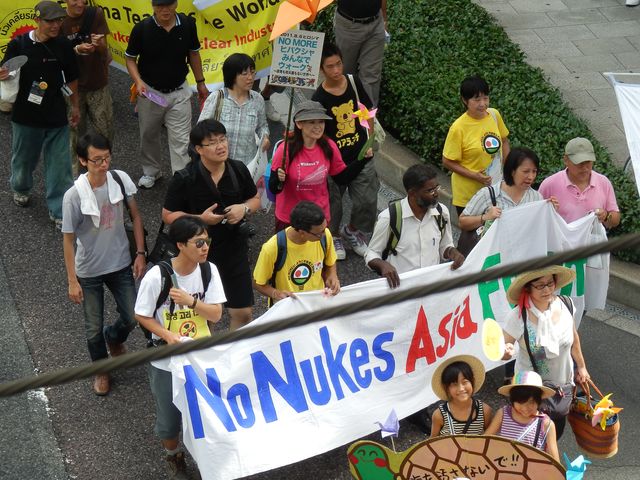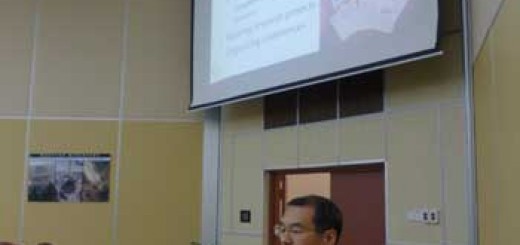The No Nukes Asia Forum 2011 Nuke Info Tokyo No. 144
The No Nukes Asia Forum 2011 was held in Japan over eight days from 30 July to 6 August. During this time, the forum also participated in the International Conference of Gensuikin, Japan’s anti-A-bomb organization, on 5 August. It was originally planned to hold NNAF 2011 in Thailand, but following the Fukushima nuclear accident NNAF members from different countries requested that the forum be held in Japan this year.
Around 30 participants took part in the forum from Indonesia, Thailand, India, the Philippines, Taiwan, and South Korea. The following is a brief description of the large number of events that took place during the eight days in Japan.
On 30 July, a seminar was held in order to share the current situation and the impacts of the Fukushima nuclear accident with the participants. Following an outline of the accident, presentations were given by Mr. Seiichi Nakate, who is working to protect children from radiation exposure, Ms. Ayako Ohga, a resident of the evacuation zone, and from Mr. Kazuoki Ohno, who analyzed the impact of the nuclear accident from the viewpoint of farmers and agriculture. An intense exchange of opinions and Q&A session was held following the presentations.
On 31 July, the forum broke up into two groups, one attending a seminar on the question of Japan’s exports of nuclear reactors at Waseda University in Tokyo, and one group participating in the “Prefectural People’s Rally to Demand a Non-Nuclear Fukushima,” held in Fukushima City. Doubts were expressed about participation in the rally due to the relatively high level of radiation in Fukushima City, but it was decided to let potential participants judge for themselves whether they would participate or not on the basis of knowledge of the radiation levels in the city. The Taiwan participants in the rally carried Geiger counters, borrowed from the government, and wore dosimeter film badges, during the event. The group participating in the rally also made study visits to Date City and Minami Soma City.
On 1 August, country reports were heard from participating countries, including a report from China. For NNAF 2011, it was decided to ask each of the participating countries to submit a country report in a unified format in order to deepen the awareness of the electrical power and nuclear power policies and the efforts of the anti-nuke movement in each country.
The Fukushima nuclear accident has had a serious impact on the plans for nuclear power station construction in Asia. In his country report on Indonesia, Dian Abraham noted that the accident has shocked people in his country who are used to being told that Japan’s nuclear power stations are safe, and people who were previously apathetic towards nuclear power projects in Indonesia have begun to express feelings of concern and anxiety.
A Thai participant, Santi, stated that a public opinion poll conducted in Thailand at the end of March showed that 83.4% of the people opposed nuclear power. A Taiwanese participant, Gao Chengyan, reported that on 20 March about 5,000 people had taken part in a demonstration in Taipei, a nationwide anti-nuke demonstration had taken place on 30 April and on 11 June, in response to a call from Japanese activists, an anti-nuke demonstration had taken place at main train stations throughout Taiwan.
Mitzi Chan, the participant from the Philippines, told the forum that the revival of the Bataan nuclear power station project, or an attempt to locate it elsewhere by conducting feasibility studies for nuclear power station siting in 13 locations in the country, was underway. In the week following the Fukushima nuclear accident, however, continual demonstrations had taken place in several locations, including in front of the gate at Bataan nuclear power station.
I Honsok, from South Korea, also noted that demonstrations had been organized on consecutive days in many locations in South Korea following the explosions at the Fukushima accident site on 12 March. Dr. Udayakumar from India reported that he has formed a nationwide network to oppose planned nuclear power stations in his country. It is clear that the anti-nuke movement is becoming more active in all of the participating countries.
The country reports were followed by discussions and the announcement of a Joint Declaration. The Declaration, under the title “Let us join hands to create a nuclear-free world,” called for a strengthening of solidarity of NNAF and demanded that countries that have nuclear power stations decommission them immediately, while countries that are planning to construct nuclear power stations completely rescind the plans. It was noted that opposition is taking place in areas where nuclear power station construction is planned in several countries, but that the voices of the people not been able to influence the behavior of central governments.
On 2 August, the group visited the Ministry of Economy, Trade and Industry to express opposition to Japan’s nuclear exports, and this was followed by a visit to the Head Office of TEPCO to present a list of requests. The forum then moved to Hiroshima.
On 3 August, the forum made a study visit to exchange opinions with the residents of Iwaishima Island, who are opposing the planned Kaminoseki nuclear power station in Hiroshima Prefecture. On the Island, the participants helped to take down the tents that had been set up as a long-term protest and lookout point on Tanoura beach (directly opposite the nuclear power station construction site) and helped to clean the beach. The aim of this activity was to encourage the Chugoku Electric Power Company to completely terminate construction, which is currently suspended, although the geological survey of the site ordered by the government (the Nuclear Safety Commission and the Nuclear and Industrial Safety Agency) is still continuing intermittently. While the participants may not have been aware of the full historical weight of the long history of opposition to the nuclear power station, it did seem that everyone was left with a strong impression of the anti-nuke movement in the area. On 4 August, the group visited the Hiroshima Peace Memorial Museum and other places of interest in Hiroshima.
At the International Conference of Gensuikin on 5 August, reports were given on nuclear exports from Japan and South Korea, and the energy policy of Taiwan. There were also reports from the USA and Germany. Baerbel Hoehn, vice chairwoman of the German Green Party and a member of the German Federal Parliament, urged Japanese activists to work patiently toward their goal of a nuclear phase-out and stated that she believes that it is important to always think and act in an alternative way. It appears that the greatest impact of the Fukushima nuclear accident has been in Germany, where the decision has been taken to implement the early decommissioning of nuclear reactors which had recently had their operational lives extended. On 6 August, the group participated in demonstrations starting from the Peace Memorial Park and took part in the anti-nuke sit-in in front of the Chugoku Electrical Power Company office.
With the help of many people in both Tokyo and Hiroshima, we were fortunate in having no illnesses or injuries during the forum despite the very busy and exhausting schedule. This was especially due to the hospitality of our friends in Hiroshima, who agreed to host the NNAF in their city. The success of the forum was also due to the hard work of those who undertook the work of drawing up paperwork for visa formalities, applying for subsidies to hold the forum and taking care of the overseas participants during their stay in Japan. We are also very grateful for donations, which were sufficient to pay for the entire activities of the forum.
It has been confirmed that plans to hold the next NNAF in South Korea in March 2012 are now moving forward.
Hideyuki Ban (CNIC Co-Director)


